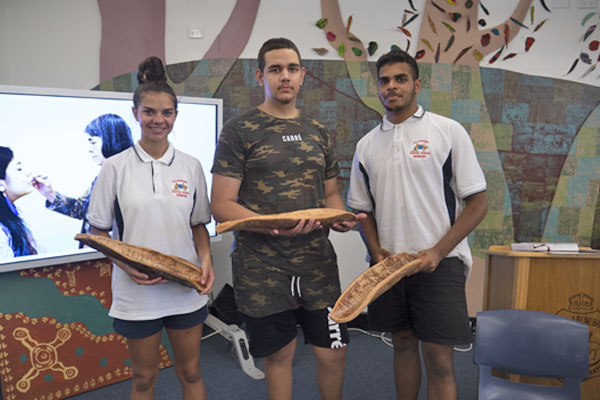Sydney, Australia: The Biennale of Sydney and the Australian Institute of Aboriginal and Torres Strait Islander Studies (AIATSIS) today announced a four year memorandum of understanding that will see these two major cultural organisations work with Aboriginal and Torres Strait Islander communities across Australia on projects that celebrate their cultures, traditions, languages and stories.
The screening of rare historic footage in the 22nd Biennale of Sydney (14 March – 8 June 2020), sourced from AIATSIS’ extensive archive of films, photographs, video and audio recordings, is the first project under this new collaboration that provides a platform for an Aboriginal community to explore and share one of their historic stories. The footage to be included in the Biennale documents the removal of sacred Dendroglyphs (carved trees) from the Kalimangl Bora Ground in northern NSW. Facilitated by AIATSIS, the Biennale sought permission from the Gamilaraay / Kamilaroi community to exhibit the film, titled Dendroglyphs of the Kalimangl Bora Ground (1949) in the Biennale’s upcoming contemporary art exhibition.
Kamilaroi Elder Roslyn McGregor invited Brook Andrew, Artistic Director of the 22nd Biennale of Sydney, and members of the Biennale of Sydney team, to visit Collarenebri, NSW and meet on country with local school children and Elders. Following a smoking ceremony, 86 students from Collarenebri Central School sang an acknowledgement song and the group viewed the archival footage from H.R. Balfour’s 1949 film.
Elder Roslyn McGregor said: ‘The Aboriginal Studies curriculum has a component where students learn about the ethics and protocols of community consultation. What better way to learn about this process than to witness it in the students’ own community? Many of these students have connections to Collarenebri through kinship and our Gamilaraay nation.’
Balfour’s ‘road movie’ contains rare footage demonstrating the destruction of religious structures by museum employed ethnologists who arrived in northern New South Wales to ‘retrieve’ dozens of Dendroglyphs from significant sites which had served as ceremonial grounds for thousands of years. By sharing this cultural significant history, the community aims to inspire Gamilaraay and other Indigenous youth to stand up and make visible these often-hidden narratives and to be proud of their cultural heritage; to be strong in language and ceremony. At the conclusion of the visit, the community gave permission for Dendroglyphs of the Kalimangl Bora Ground to screen at the Museum of Contemporary Art Australia during the upcoming edition of the Biennale.
Brook Andrew, Artistic Director for the 22nd Biennale of Sydney said: ‘It is important that communities have first say in the legacy, depiction and presentation of cultural materials. NIRIN, the title of the exhibition, meaning ‘edge’ in Wiradjuri, is about exposing that the urgent states of our contemporary lives are laden with unresolved past anxieties and hidden layers of the supernatural.
By working directly with communities, artists and creatives have the power to resolve, heal, dismember and imagine futures of transformation for re-setting the world. Sovereignty is at the centre of these actions. The community has control of how material, culture and histories are exhibited. In Gamilaraay, the Elders were especially interested in the importance of their children understanding these histories and for international audiences to understand the impact of cultural removal.’
Barbara Moore, Chief Executive Officer, Biennale of Sydney said: ‘AIATSIS and the Biennale of Sydney are working together to provide platforms that support Aboriginal and Torres Strait Islander artists, film makers, storytellers and writers through commissioning, showcasing and providing access to their ideas and expressions. Both organisations play an important role in Australia’s cultural engagement with the world and in shaping national narratives at the interface of arts and culture, and we can do that better by working closely with each other. We are excited to begin this significant partnership and look forward to presenting public programs and learning activities that support cultural resurgence, healing, sovereignty and transformation for the First People of Australia.’
Craig Ritchie, Chief Executive Officer, AIATSIS said: ‘AIATSIS is delighted to be working with the Biennale of Sydney to create transformative experiences of Aboriginal and Torres Strait Islander cultures, histories and heritage. AIATSIS’ vast collections, comprising over a million items, are a conduit to more than 60,000 years of the national story. By working in partnership with the Biennale of Sydney and First Nations communities, we can help the world to encounter and engage with that story and ensure Aboriginal and Torres Strait Islander people’s knowledge and cultures are celebrated.’
The 22nd Biennale of Sydney, titled NIRIN, is a major international exhibition of contemporary art presented across Sydney from 14 March – 8 June 2020.
Media enquiries:
Commsmedia@aiatsis.gov.au or P: 02 6261 4241
